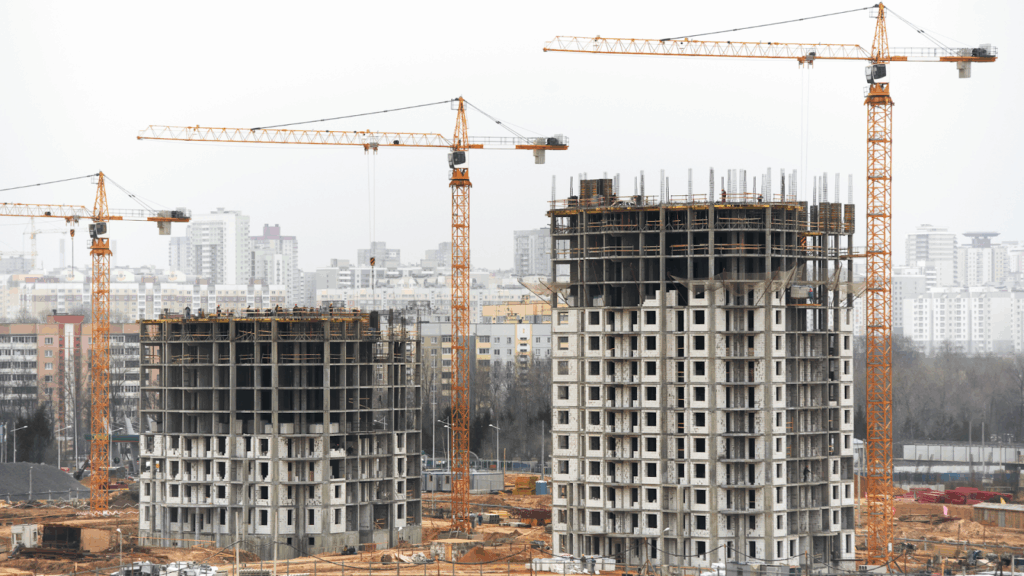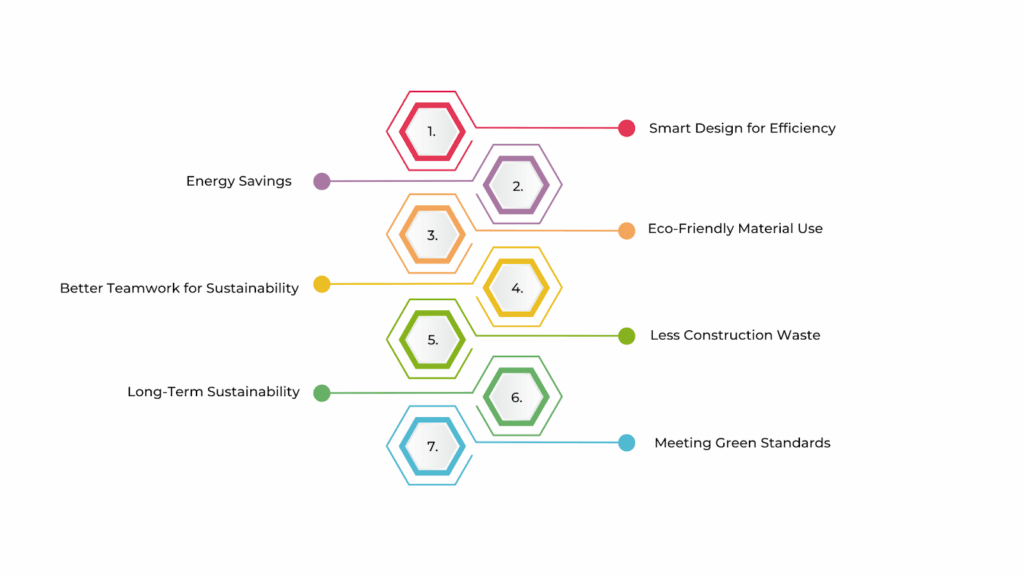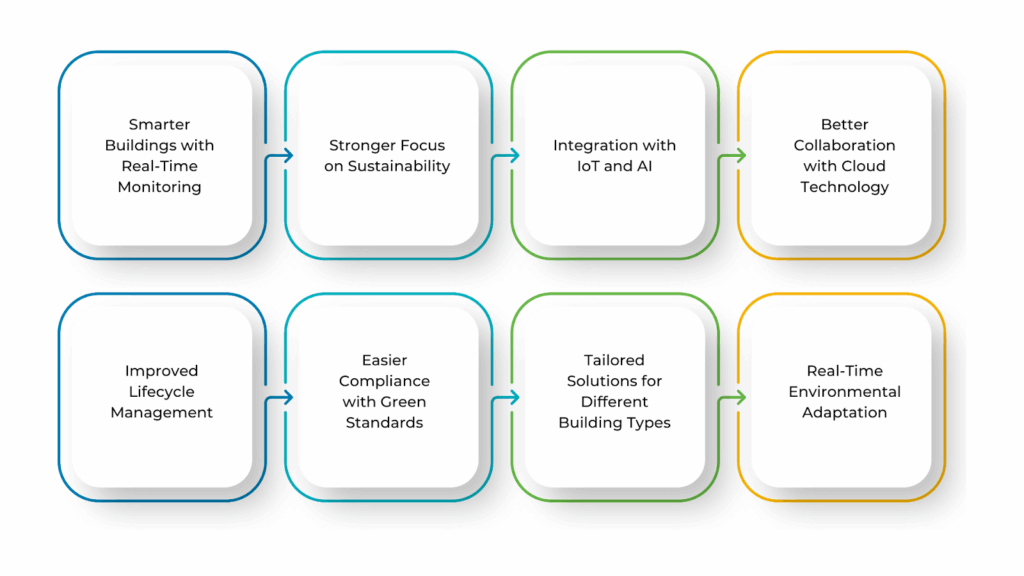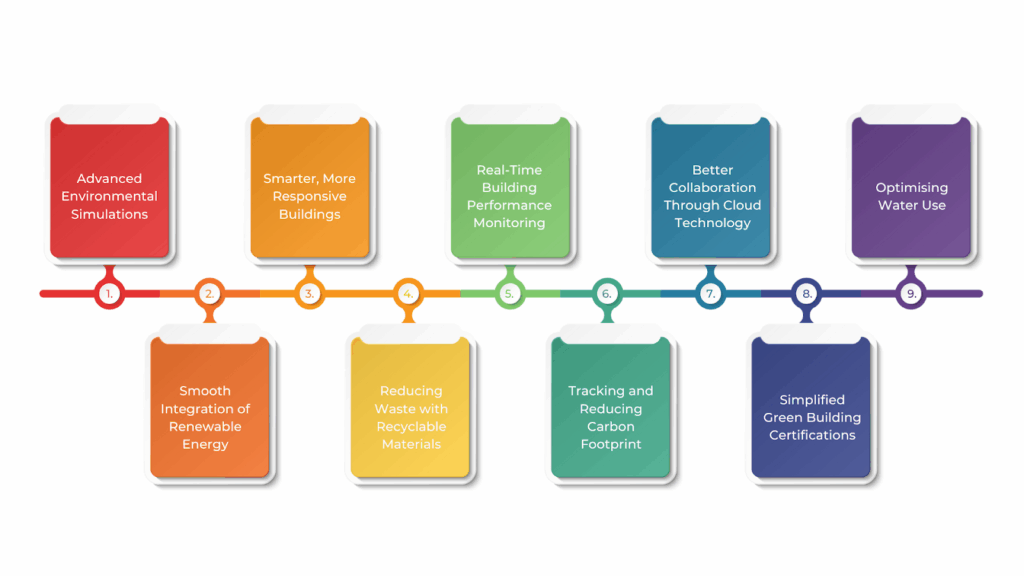In recent years, the modern construction industry has focused more on sustainability, aiming to reduce environmental impact and build energy-efficient structures. Building Information Modelling (BIM) has become a key tool in this shift, helping design, construct, and manage green buildings.
One major innovation is 6D BIM, which adds sustainability data to traditional 3D BIM models. It helps track energy use, reduce waste, and improve efficiency throughout a building’s life.
In this article, you’ll explore how BIM, especially 6D BIM, transforms modern construction. From its basics to its role in greener buildings, you’ll see how it’s shaping a more sustainable future.
What Is 6D BIM?

6D BIM (Building Information Modelling) goes beyond 3D design modelling by adding important data for the entire lifecycle of a building. It includes time (4D) and cost (5D) and focuses on sustainability and facility management. This means it helps track energy use, optimise resources, and reduce environmental impact.
With 6D BIM, building owners, developers, and managers can make better decisions about maintenance, efficiency, and long-term costs. It provides a complete picture—from design and construction to operation and even demolition—ensuring smarter planning and reduced expenses.
Understanding 6D BIM is just the beginning; its true impact lies in how it supports green and sustainable building.
Importance of Green and Sustainable Building
Green and sustainable buildings help reduce environmental damage, save energy, and use resources wisely. They are designed to be energy-efficient, use renewable materials, and lower their impact on nature in its life cycle.
Here’s why green buildings are a smart choice for a sustainable future:
- Better for the Environment: Uses less energy, lowers carbon emissions, and protects natural resources.
- Energy Efficient: Saves energy with smart technologies, renewable sources, and better insulation.
- Cost-Effective: May cost more upfront but reduces energy and water bills over time.
- Higher Property Value: More attractive to buyers and tenants who prefer eco-friendly spaces.
- Healthier Spaces: Improves air quality, lighting, and ventilation, boosting comfort and productivity.
- Meets Regulations: Helps follow environmental laws and sustainability standards.
- Saves Resources: Uses renewable materials, reducing dependence on limited natural resources.
As the need for sustainable construction continues to rise, the requirement for smarter tools becomes clear. This is where BIM comes in.
Also read: A Guide to Building Information Modelling (BIM) Impact on Modern Construction Industry.
Correlation between BIM and Green Building

The construction industry is shifting toward more sustainable practices, and Building Information Modelling (BIM) is playing a key role in making buildings greener. BIM helps architects and engineers design energy-efficient structures, reduce material waste, and improve overall building performance.
By using detailed data, records, and simulations, BIM ensures that projects meet environmental standards while also saving costs and supporting long-term sustainability. Here’s how BIM and green building are connected:
Smart Design for Efficiency
BIM helps architects, engineers, and contractors create detailed 3D models that improve energy efficiency and reduce resource waste. This ensures buildings are designed with sustainability, using eco-friendly materials and smart energy solutions.
Energy Savings
BIM includes tools for energy modelling, allowing teams to test and improve a building’s heating, cooling, and lighting efficiency before construction begins. This helps lower energy use and reduce the building’s carbon footprint.
Eco-Friendly Material Use
With BIM, teams can track and choose sustainable materials, ensuring responsible sourcing, recycling, and minimal waste. This leads to greener construction practices.
Better Teamwork for Sustainability
BIM improves coordination between designers, builders, and facility managers, helping them work together more efficiently. This reduces errors, saves materials, and encourages sustainable practices throughout the project.
Less Construction Waste
By creating highly accurate digital models, BIM helps construction teams plan and use materials more effectively, reducing waste and optimising resources.
Long-Term Sustainability
BIM supports building maintenance and performance tracking, ensuring that energy efficiency and sustainability continue after construction.
Meeting Green Standards
BIM helps projects comply with green building certifications like LEED and BREEAM, making it easier to meet environmental requirements for energy use, water conservation, and sustainable site development.
Ready to simplify your projects and achieve the benefits?
BIM ASSOCIATES is your one-stop BIM Solution provider for Revit Architectural and Structural Solutions. They coordinate with your team to develop, record, and streamline the BIM Revit Model, along with the sheets, Bill of Quantities, Bill of Materials, and clash coordination.
BIM has already shown its value in promoting green building by improving efficiency and reducing waste. However, 6D BIM takes sustainability a step further.
How Does 6D BIM Enhance Sustainability in Construction?
Sustainability is becoming more important in construction, and 6D BIM is helping create greener buildings. Unlike traditional BIM, 6D BIM includes sustainability data, allowing teams to track energy use, costs, and environmental impact from the beginning. This helps reduce waste, improve energy efficiency, and ensure buildings remain sustainable over time.
6D BIM is making construction more eco-friendly and efficient by:
- Improving Energy Efficiency: 6D BIM helps design buildings that use less energy by analysing data on energy consumption and environmental impact. This leads to lower energy costs and a reduced carbon footprint.
- Choosing Sustainable Materials: With 6D BIM, materials are selected based on their environmental impacts, such as carbon emissions, recyclability, and waste production. This ensures the use of eco-friendly materials in construction.
- Managing a Building’s Entire Lifecycle: 6D BIM tracks a building from construction to maintenance, ensuring resources are used efficiently. It also helps plan regular maintenance to keep buildings energy-efficient and sustainable over time.
- Reducing Waste: By improving accuracy in construction planning, 6D BIM minimises material waste and prevents errors. This leads to better resource use and less waste during construction and demolition.
- Tracking Carbon Footprint: 6D BIM includes tools to monitor and measure a building’s carbon footprint at every stage. This helps teams make better decisions to reduce environmental impact.
- Monitoring Building Performance After Construction: Even after construction is complete, 6D BIM tracks energy use, water consumption, and air quality. This ongoing data helps improve building performance and maintain sustainability goals.
- Integrating Renewable Energy: 6D BIM helps incorporate renewable energy solutions such as solar panels and geothermal heating, ensuring they are properly installed and perform efficiently throughout the building’s lifespan.
6D BIM is continuously shaping the construction industry, and its ability to enhance sustainability is becoming increasingly apparent. By considering the entire building lifecycle, 6D BIM enhances efficiency in design and construction while delivering long-term environmental benefits.
What Does the Future Hold for 6D BIM?

As the construction industry focuses more on sustainability, 6D BIM will become even more critical. New technology will provide better energy modelling, smarter building system integration, and improved data analysis to support long-term sustainability.
The future of 6D BIM holds significant potential for transforming the construction industry by making buildings more sustainable, efficient, and data-driven. The future predictions for 6D BIM are as follows:
Smarter Buildings with Real-Time Monitoring
As technology advances, 6D BIM will connect more with smart building systems. This means buildings will track energy use, air quality, and other sustainability factors in real time, making operations more efficient and automated.
Stronger Focus on Sustainability
With the growing demand for eco-friendly buildings, 6D BIM will include advanced tools to monitor carbon emissions and resource consumption. This will help create greener and more energy-efficient structures.
Integration with IoT and AI
By working with Internet of Things (IoT) devices and Artificial Intelligence (AI), 6D BIM will enable buildings to predict maintenance needs and improve efficiency without human input. This will reduce costs and energy waste.
Better Collaboration with Cloud Technology
As 6D BIM becomes more cloud-based, architects, contractors, and facility managers can access real-time data from anywhere. This will improve teamwork, speed up decision-making, and enhance project results.
Improved Lifecycle Management
Future developments in 6D BIM will better track a building’s performance over time. Maintenance schedules will be smarter, ensuring buildings remain energy-efficient and sustainable for decades.
Easier Compliance with Green Standards
As sustainability regulations become stricter, 6D BIM will help buildings automatically meet certification requirements like LEED or BREEAM. This will simplify the approval process and ensure compliance with environmental laws.
Tailored Solutions for Different Building Types
6D BIM will become more flexible, adapting to different types of buildings—from homes to large commercial or industrial structures. This will make sustainability strategies more precise and effective for each sector.
Real-Time Environmental Adaptation
With access to live environmental data, such as weather patterns and resource availability, 6D BIM will help buildings adjust dynamically to external conditions, improving both sustainability and efficiency.
Future of BIM in Sustainable Building

As construction focuses more on sustainability, the future of Building Information Modelling (BIM) looks bright. New advancements in BIM will help buildings use less energy, produce less waste, and manage resources more efficiently.
With technologies like AI, IoT, and real-time data, BIM will play a key role in creating eco-friendly buildings that meet sustainability goals and regulations.
BIM is shaping the future of sustainable construction in the following ways:
Advanced Environmental Simulations
Future BIM technology will be able to simulate energy use, carbon emissions, and water consumption more accurately. This will help architects and engineers design buildings that are sustainable from the start.
Smooth Integration of Renewable Energy
BIM will make it easier to include solar panels, wind turbines, and geothermal heating in building designs. These systems will be optimised for maximum efficiency, reducing dependence on non-renewable energy sources.
Smarter, More Responsive Buildings
With the rise of smart cities, BIM will help integrate IoT (Internet of Things) devices into buildings. This will allow buildings to automatically adjust heating, cooling, and lighting based on real-time conditions, improving energy efficiency.
Reducing Waste with Recyclable Materials
BIM will support a circular economy by tracking materials and their potential for reuse. This will encourage using recyclable and renewable materials, reducing construction waste and minimising the need for new resources.
Real-Time Building Performance Monitoring
Even after construction, BIM will continuously track a building’s energy use, water consumption, and overall efficiency. This will enable ongoing improvements to make buildings more sustainable over time.
Tracking and Reducing Carbon Footprint
BIM will help measure and minimise a building’s carbon footprint at every stage—from construction to demolition—assisting projects in meeting stricter environmental regulations and sustainability goals.
Better Collaboration Through Cloud Technology
BIM will improve teamwork by enabling real-time data sharing between architects, engineers, contractors, and facility managers. This will speed up decision-making and ensure sustainability is prioritised at every project stage.
Simplified Green Building Certifications
BIM will integrate with certification systems like LEED and BREEAM, making it easier for buildings to meet sustainability standards. This will reduce delays and costs in the certification process.
Optimising Water Use
Future BIM models will improve water efficiency by helping design smart plumbing, rainwater harvesting, and recycling systems. This will further reduce a building’s environmental impact.
BIM Supports GREEN EARTH.
Conclusion
Building Information Modelling (BIM) helps create sustainable buildings by improving energy use, reducing waste, and making better use of materials. It also enhances planning and teamwork, allowing architects, engineers, and contractors to design eco-friendly and cost-effective buildings.
Looking ahead, BIM will play an even bigger role. New technologies like IoT and AI will enable real-time monitoring and smarter building management, helping cities and construction become more sustainable.
Are you looking for BIM solutions?
BIM ASSOCIATES is your one-stop BIM Solution provider for the Architecture and Structure discipline. Their solutions help clients with better decision-making, cost-saving, efficient construction planning, and green earth initiatives.
You might also like: BIM Levels and Stages of Development Explained.
FAQs (Frequently Asked Questions)
1. What is a BIM environment?
A BIM environment is a digital space where all project data is stored and shared. It allows architects, engineers, and contractors to work together smoothly, improving construction efficiency and precision.
2. Does BIM reduce waste?
Yes, BIM helps reduce waste by improving planning, preventing errors, and optimising material use. This leads to less rework and lower costs.
3. Who benefits from BIM?
BIM benefits architects, engineers, contractors, and owners by improving efficiency, reducing costs, and ensuring better project outcomes. It also promotes sustainability by supporting eco-friendly construction practices.

